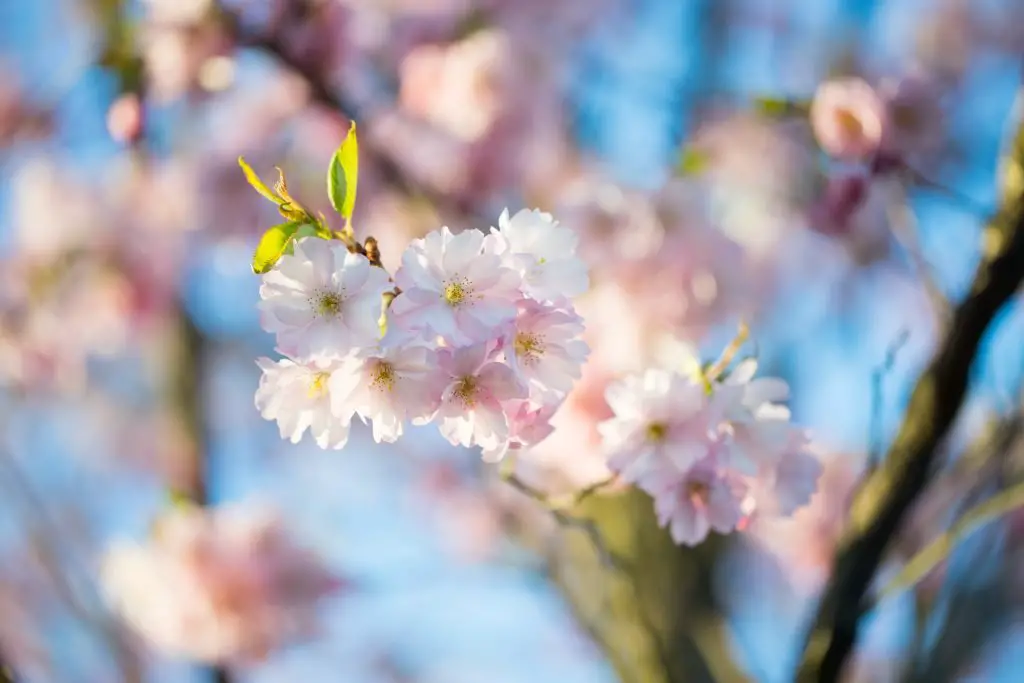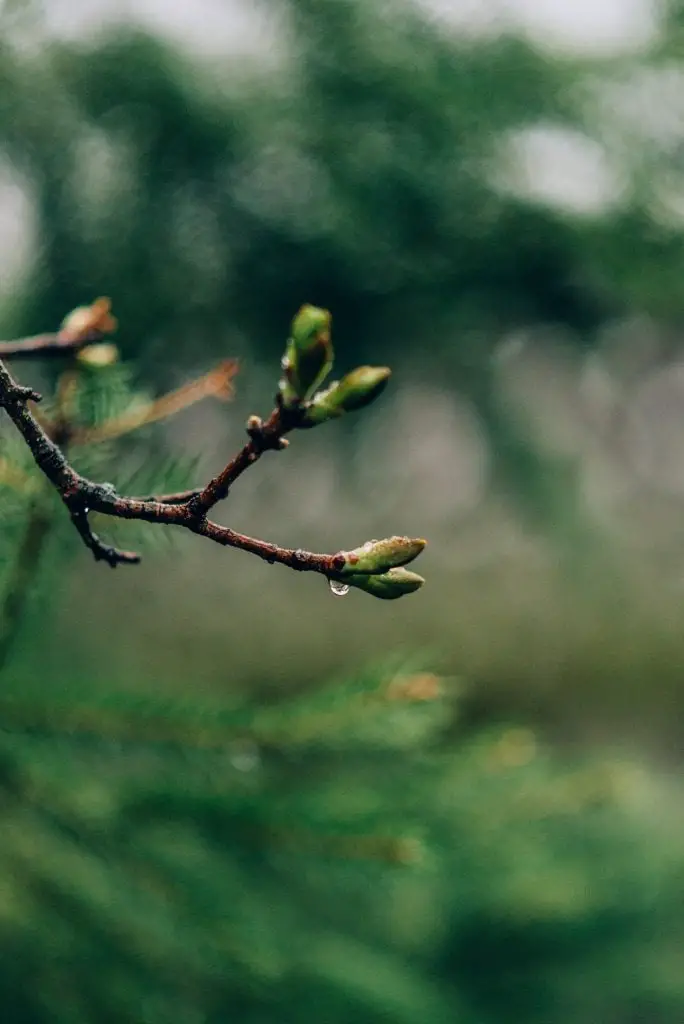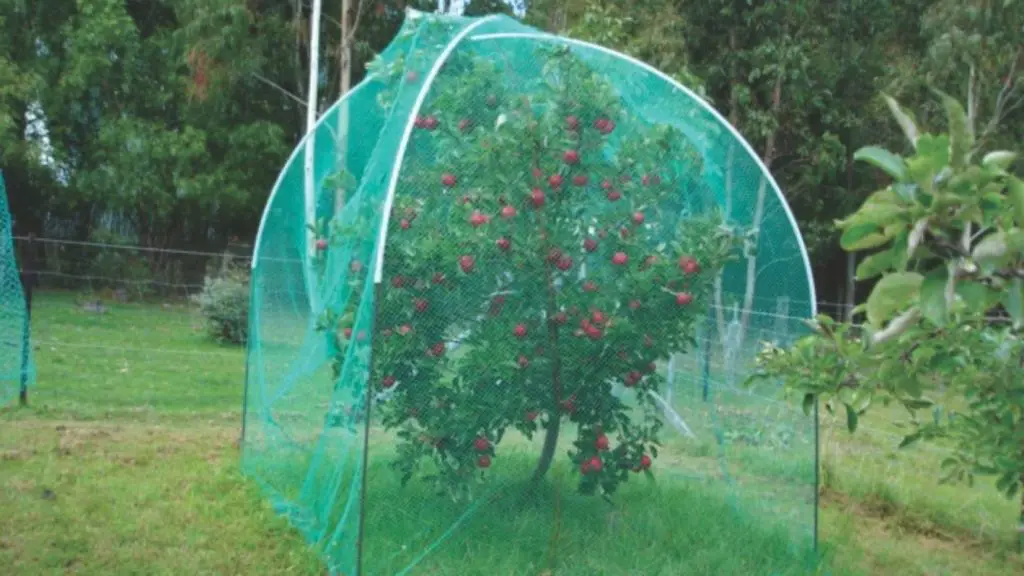At What Temperature Should You Cover Fruit Trees? If you live in a region that has cold winters, particularly one that is prone to late frosts in Spring it is important to protect the trees to ensure that you have a good harvest in Summer and Autumn, so at what temperature does the tree need protection?
The temperature at which frost protection needs to be applied to a fruit tree is dependent upon the type of tree and stage of bud formation or flowering the tree is at. However, as a general rule frost protection should be applied when the temperature falls below 28°F (-2°C) for trees with buds only and at 32°F (0°C) or below if the tree is in flower.
These recommendations are based on a range of publications from Michigan and Washington State Universities which compiled data on the critical temperatures that affect bud and flower development of a range of fruit trees at different stages of development.
The ability of the tree to withstand cold temperatures reduces as the formation of the buds and flowers progresses. The key stages, that are common to all fruit trees are the swelling of buds, first bloom, full bloom, and post-bloom. Post bloom refers to the period when flowers have died back and the formation of fruit can be observed.

A general recommendation for each type of fruit is provided in the table below however the specific critical temperatures along with photographs of what the development stages look like have been included at the end of the article for your reference.
| Fruit Tree | Comments |
| Apricot | Frost protection should be applied when the temperature falls below 23°F (-5°C) if there is no sign of white on the buds and after that period the tree needs to be protected at 30°F (-1°C) or below when flowers have formed. |
| Apple | It is recommended that frost protection be applied to apples when the temperature is forecast to fall below 28°F (-2°C) prior to bloom and 30°F (-1°C) once flowers form. |
| European Plums* | Frost protection should be applied when the temperature falls below 23°F (-5°C) if there is no sign of white on the buds and after that period the tree needs to be protected at 30°F (-1°C) or below when flowers have formed. |
| Peaches/Nectarines** | Frost protection should be applied when the temperature falls below 24°F (-4°C) if there is no sign of white on the buds and after that period the tree needs to be protected at 30°F (-1°C) or below when flowers have formed |
| Pears | It is recommended that frost protection be applied when the temperature falls below 24°F (-4°C) if there is no sign of white on the buds and after that period the tree needs to be protected at 30°F (-1°C) or below when flowers have formed. |
| Sour Cherries | Frost protection be applied when the temperature falls below 25°F (-4°C) if there is no sign that the buds have begun to break and after that period the tree needs to be protected at 30°F (-1°C) |
| Sweet Cherries | Frost protection be applied when the temperature falls below 25°F (-4°C) if there is no sign that the buds have begun to break and after that period the tree needs to be protected at 30°F (-1°C) |
* European Plums generally are more tolerant of cold than Japanese Plums due to their later flowering period. I assume the critical temperatures for Japanese Plums will be similar to European Plums but there are no specific studies on Japanese Plums
** The studies specifically refer to Peaches rather than Nectarine. However, they are a variant of the same species so they should behave in a similar manner
How To Protect Your Fruit Tree Against Frost
To reduce the chance of frost damage to trees there are several structural things that can be done in your garden. These are as follows;
- Plant fruit trees in locations that are relatively warm. This means plant them in a south-facing location to maximize solar exposure.
- Plant the trees near stone or brick structures such as a house. This will increase the temperature at night as the energy absorbed during the day by the bricks and stone will be released at night.
- Avoid planting the trees in exposed sites that can be buffeted by the prevailing wind.
- Avoid low-lying areas that can create a frost hollow as a result of cold air sinking into low-lying areas.
- The size of fruit trees needs to be controlled to allow frost protection to be placed over the tree easily. Espalier trees are particularly suited to the application of frost protection, to read more about this click on the link.
Applying Frost Protection To Fruit Trees
Even with all the best garden design and planning, frosts, particularly late ones, that arrive after the plants have begun flowering can be problematic. In these circumstances, the only option is to cover up the fruit trees. To do this a multitude of different materials can be used which can include horticultural fleece, plastic sheets, or even old bed linin.
Whatever you choose to cover the trees in it is important to ensure it extends to ground level to improve your chances of trapping the warm air around the tree.

When placing the cover over the top of the tree it is best to avoid having the cover sitting directly on top of buds or blossoms. Ideally, to do this you need to have the covers suspended above the tree.
Creating A Frame
The easiest way to create a relatively large frame for your frost protection is using metal star pickets (4 to 6 ft lengths is ideal), PVC piping, and either electrical conduit or relatively thick but flexible water piping.
To assemble the frame start by driving the star pickets into the ground in the locations around the tree. At least 4 pickets will be required, but it is possible to add more if there is insufficient support for the netting.
Once the star pickets are in position place the PVC piping over the star pickets to create the uprights for the structure. The PVC should be precut to length to suit the height of the structure and the width of the pipe purchased should be large enough to fit snuggly over the star pickets to ensure there is minimal movement as this will avoid the need to use screws.
With uprights in place use the electrical conduit/water piping to create arches between pairs of uprights. To connect the arches to the uprights the electrical conduit/water piping should be narrower than the PVC piping used for the uprights. This will allow electrical conduit/water piping to fit inside the PVC securing it in position without the need to use screws.
To increase the stability of the structure to arches should run perpendicular (90 degrees) to each other as this will allow a cable tie to be used to tie them together at the apex of the structure.

In terms of the netting itself, there are a large number of products available on Amazon that are suitable for the protection of trees, however, many are not sufficiently large to cover a fruit tree. The one that we recommend is the Haxnicks Fruit Tree Netting Cover which comes in sizes up to 13ft by 13ft, click the link to see the latest price on Amazon.
The product is a 0.4” inch (1mm) weave that is strong and durable and will allow light and moisture through to the tree which makes it useful for both frost protection and netting against birds. However, due to the relatively fine weave, the covers need to be removed during the day when the tree is in bloom to allow insects to pollinate the flowers.
Additionally, the product features an easy-to-use “lift over” design with a sealable opening which makes the netting easy to install. The short video below shows the method used to install it on a fruit tree.
The Critical Temperature For Fruit Trees
The critical temperatures, as quoted by Washington State and Michigan State Universities are based on the lowest temperature the buds and flowers can withstand without damage for a period of 30 minutes at three different levels of survival, 100%, 90%, and 10%. These values vary depending on the stage of development and the particular type of tree in question.
Critical Temperatures For Apples
There are 9 developmental stages associated with the formation of apples that have been identified in a study by Washington State University. Images of these stages are shown below.

The temperature at the three survival rates of buds at each developmental stage is provided in the table below along with an approximate date when this occurs. This data is based on the Red Delicious apple variety but will vary slightly with different cultivars.
| Date | Development Stage | 100% Survival | 90% Survival | 10% Survival |
| – | Silver Tip | 16°F (-9°C) | 15°F (-9°C) | 2°F (-17°C) |
| 3/20 | Green Tip | 16°F (-9°C) | 18°F (-8°C) | 10°F (-12°C) |
| 3/27 | 0.5 Inch Green | 22°F (-6°C) | 23°F (-5°C) | 15°F (-9°C) |
| 4/3 | Tight Cluster | 27°F (-3°C) | 27°F (-3°C) | 21°F (-6°C) |
| 4/8 | First Pink | 27°F (-3°C) | 28°F (-2°C) | 24°F (-4°C) |
| 4/11 | Full Pink | 28°F (-2°C) | 28°F (-2°C) | 25°F (-4°C) |
| 4/18 | First Bloom | 28°F (-2°C) | 28°F (-2°C) | 25°F (-4°C) |
| 4/25 | Full Bloom | 29°F (-2°C) | 28°F (-2°C) | 25°F (-4°C) |
| – | Post Bloom | 29°F (-2°C) | 28°F (-2°C) | 25°F (-4°C) |
Critical Temperatures For Pears
The developmental stages identified for pears are slightly different, see the image below Images of these stages is shown below.

The temperature at the three survival rates of buds at each developmental stage is provided in the table below.
| Development Stage | 100% Survival | 90% Survival | 10% Survival |
| Bud Swell | 18°F (-8°C) | 15°F (-9°C) | 0°F (-18°C) |
| Bud Burst | 23°F (-5°C) | 20°F (-7°C) | 6°F (-14°C) |
| Tight Cluster | 24°F (-4°C) | 24°F (-4°C) | 15°F (-9°C) |
| First White | 28°F (-2°C) | 25°F (-4°C) | 19°F (-7°C) |
| Full White | 29°F (-2°C) | 26°F (-3°C) | 22°F (-6°C) |
| First Bloom | 29°F (-2°C) | 27°F (-3°C) | 23°F (-5°C) |
| Full Bloom | 29°F (-2°C) | 28°F (-2°C) | 24°F (-4°C) |
| Post Bloom | 30°F (-1°C) | 28°F (-2°C) | 24°F (-4°C) |
Critical Temperatures For Peaches
The developmental stages identified for Peaches are shown in the images below.

The temperature at the three survival rates of buds at each developmental stage is provided in the table below.
| Date | Development Stage | 100% Survival | 90% Survival | 10% Survival |
| 3/7 | First Swelling | 23°F (-5°C) | 18°F (-8°C) | 1°F (-17°C) |
| 3/16 | Calyx Green | – | 21°F (-6°C) | 5°F (-15°C) |
| 3/19 | Calyx Red | – | 23°F (-5°C) | 9°F (-13°C) |
| 3/29 | First Pink | 25°F (-4°C) | 25°F (-4°C) | 15°F (-9°C) |
| 4/3 | First Bloom | – | 26°F (-3°C) | 21°F (-6°C) |
| 4/11 | Full Bloom | 27°F (-3°C) | 27°F (-3°C) | 24°F (-4°C) |
| 4/18 | Post Bloom | 30°F (-1°C) | 28°F (-2°C) | 25°F (-4°C) |
Critical Temperatures For Sweet Cherries
The developmental stages identified for Sweet Cherries are shown in the images below.

The temperature at the three survival rates of buds at each developmental stage is provided in the table below.
| Date | Development Stage | 100% Survival | 90% Survival | 10% Survival |
| 3/5 | First Swelling | 23°F (-5°C) | 17°F (-8°C) | 15°F (-5°C) |
| 3/13 | Side Green | 23°F (-5°C) | 22°F (-6°C) | 9°F (-13°C) |
| 3/23 | Green Tip | 25°F (-4°C) | 25°F (-4°C) | 14°F (-10°C) |
| 3/27 | Tight Cluster | 28°F (-2°C) | 26°F (-3°C) | 17°F (-8°C) |
| 4/1 | Open Cluster | 28°F (-2°C) | 27°F (-3°C) | 21°F (-6°C) |
| 4/4 | First White | 29°F (-2°C) | 27°F (-3°C) | 24°F (-4°C) |
| 4/8 | First Bloom | 29°F (-2°C) | 28°F (-2°C) | 25°F (-4°C) |
| 4/13 | Full Bloom | 29°F (-2°C) | 28°F (-2°C) | 25°F (-4°C) |
| 4/21 | Post Bloom | 30°F (-1°C) | 28°F (-2°C) | 25°F (-4°C) |
Critical Temperatures For European Plums
The developmental stages identified for European Plums are shown in the images below.

The temperature at the three survival rates of buds at each developmental stage is provided in the table below.
| Development Stage | 100% Survival | 90% Survival | 10% Survival |
| First Swelling | – | 14°F (-10°C) | 0°F (-18°C) |
| Side White | – | 17°F (-8°C) | 3°F (-16°C) |
| Tip Green | – | 20°F (-7°C) | 7°F (-14°C) |
| Tight Cluster | – | 24°F (-4°C) | 16°F (-9°C) |
| First White | 23°F (-5°C) | 26°F (-3°C) | 22°F (-6°C) |
| First Bloom | 27°F (-3°C) | 27°F (-3°C) | 23°F (-5°C) |
| Full Bloom | 27°F (-3°C) | 28°F (-2°C) | 23°F (-5°C) |
| Post Bloom | 30°F (-1°C) | 28°F (-2°C) | 23°F (-5°C) |
Critical Temperatures For Apricots
The developmental stages identified for Apricots are shown in the images below.

The temperature at the three survival rates of buds at each developmental stage is provided in the table below.
| Development Stage | 100% Survival | 90% Survival | 10% Survival |
| Swollen Bud | – | 15°F (-5°C) | – |
| Tips Separate | 23°F (-5°C) | 20°F (-7°C) | 0°F (-18°C) |
| Calyx Red | – | 22°F (-6°C) | 9°F (-13°C) |
| First White | 25°F (-4°C) | 24°F (-4°C) | 14°F (-10°C) |
| First Bloom | – | 25°F (-4°C) | 19°F (-7°C) |
| Full Bloom | 28°F (-2°C) | 27°F (-3°C) | 22°F (-6°C) |
| In the shuck | – | 27°F (-3°C) | 24°F (-4°C) |
| Green Fruit | 31°F (-1°C) | 28°F (-2°C) | 25°F (-4°C) |
Critical Temperatures For Sour Cherries
The developmental stages identified for Sour Cherries are shown in the images below.

The temperature at the three survival rates of buds at each developmental stage is provided in the table below.
| Development Stage | 90% Survival | 10% Survival |
| Swollen Bud | 15°F (-5°C) | 0°F (-18°C) |
| Side Green | 24°F (-4°C) | 10°F (-13°C) |
| Green Tip | 26°F (-3°C) | 22°F (-6°C) |
| Tight Cluster | 26°F (-3°C) | 24°F (-4°C) |
| Open Cluster | 28°F (-2°C) | 24°F (-4°C) |
| First White | 28°F (-2°C) | 24°F (-4°C) |
| First Bloom | 28°F (-2°C) | 24°F (-4°C) |
| Full Bloom | 28°F (-2°C) | 24°F (-4°C) |
